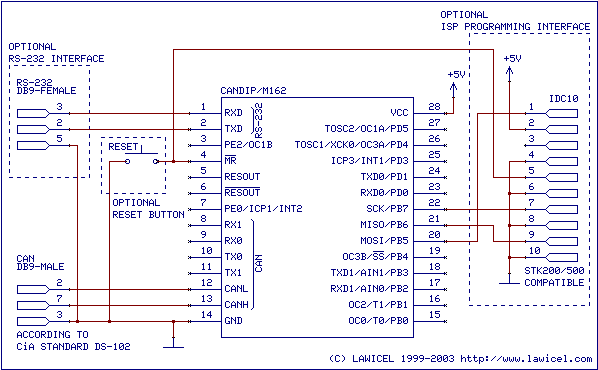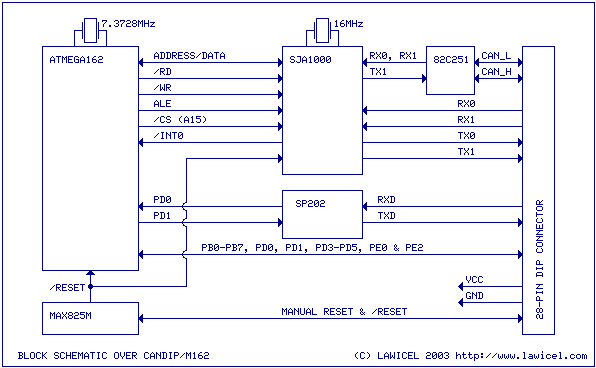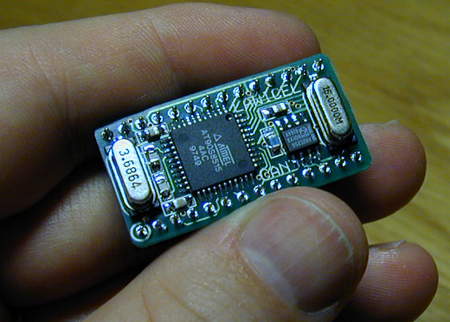
LAWICEL CANDIP
NOTE: This product, developed back in 1997, has been discontinued in 2012. However, with an MOQ applied, we still would be able to build a new batch of these modules. This page is here for reference for those who work(ed) with these devices.

The picture above shows the CANDIP/M162, which has the size of a DIP28. The CANDIP/M162 is equipped with an Atmel AVR microcontroller type ATMega162 and the CAN controller SJA1000 from Philips.
What is CANDIP/M162?
CANDIP/M162 is an embedded microcontroller with CAN (Controller Area Network), where you as a user can make a quick route to new products, maybe you just need some digital I/O connected to CAN or a a smart node with a PID controlled motor etc. You can see the CANDIP/M162 as a very small “Single Board Computer” with the possibility to perform almost 8MIPS (even thought the AVR can run up to 16Mhz, we have chosen to use 7.3828Mhz to minimize current and keep backwards compability to the CANDIP/AVR1M module. We have tested the unit with 16Mhz without any problems and as a user you can change the chrystal on your own or if larger quantity order from us mounted and tested with any chrystal up to 16Mhz).
CANDIP/M162 isn’t just a “ready to use module with pre-programmed software” which has a very narrow application field, such as a CANopen SLIO or a homebrewed Protocol SLIO, it is completely scalable with your own software (written in C, Basic, Forth, Pascal or any other compiler that supports the Atmel AVR ATmega162). We can of course pre-program it to behave as you like incase you do not have the time or knowledge.
CANDIP/M162 also has on-board RS-232 transceivers and a RESET circuit that generates a proper reset after power up and will also halt the microcontroller if the voltage drops below 4.38V. Furthermore it has a standard ISO-11898 CAN transceiver on board, but could also use an external CAN transceiver with your own hardware with e.g. OPTO isolation.
CANDIP/M162 has a few I/O connections on board that could be used for general I/O, but it can easily be expanded to a real advanced and sophisticated system through the SPI port. Through the SPI port you could add hardware such as digital I/O, ADC, DAC, RTC, EEPROM, LCD and much more. You can also attach I2C devices and control them by software controlled I2C. There is also two external Interrupt lines available (INT1 & INT2), the other on the ATmega162 (INT0) is used for the CAN controller.
CANDIP/M162 support In-System-Programming (ISP), which means you can program the software without removing it from the socket. Just use your favorite AVR ISP programmer or buy one from us. We sell our own low cost ispAVRp which is compatible with ICCAVR, CV & BASCOM-AVR. So we can offer a complete solution and get you started in just a few hours (such as compilers and customized software).
CANDIP/M162 can also be programmed with a BOOTLOADER which makes it possible to download your application though the RS232 or CAN interface.

The picture above shows how to connect the CANDIP/M162 and external components needed. Dashed blocks are optional connections depending on your application. The CANDIP/M162 supports In-System-Programming (ISP) through the SPI port and it supports the STK200/300 programmer from Atmel or ispAVRp from LAWICEL or many other 3:rd party programmers.

The picture above shows the internal block diagram of CANDIP/M162. The real schematic of the CANDIP/M162 is not included since it is an end product. The CANDIP/ST2M162 includes a CDROM with sample programs, manuals and demo software for the WiCAN CAN library. The CAN controller is reachable from 0x0000-0x7FFF (decoded by A15), but first after the internal RAM of the Mega162. The INT0 of the Mega162 is connected to the SJA1000 Interrupt line for interrupt driven CAN.

Just see how small the CANDIP/M162 is. CANDIP/M162 is perfect for small systems such as Home Automation, small and effective CAN nodes with e.g. digital I/O or Analog I/O, use it for expanding your existing embedded system through the SPI or RS-232 channel. It can also be used for simple test and learning CAN. The CANDIP/M162 is easy to expand into a large system through the SPI port or via software controlled I2C.